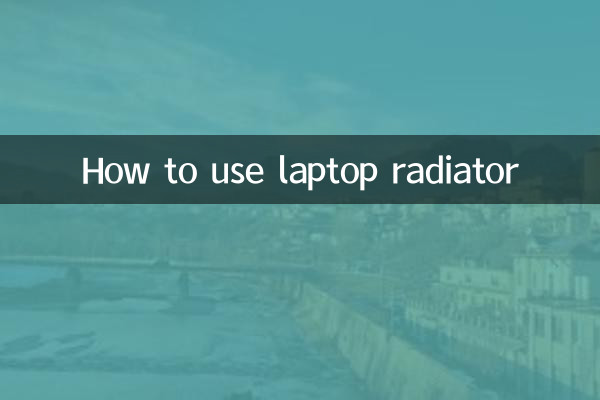How to use laptop radiator
With the arrival of high temperatures in summer, the heat dissipation problem of laptops has become the focus of many users. How to use laptop radiator correctly to improve cooling efficiency? This article will provide you with a comprehensive guide from the types of radiators, usage methods, precautions, and recent popular radiator recommendations.
1. Types of laptop radiators

Laptop radiators currently on the market are mainly divided into the following categories:
| type | Features | Applicable scenarios |
|---|---|---|
| Air cooling radiator | Active cooling via fan, lower price | Daily office work, light gaming |
| water cooling radiator | High heat dissipation efficiency and low noise | High performance notebook, long gaming time |
| Metal cooling pad | Passive cooling, no noise | Thin and light notebook, temporary use |
| Exhaust draft radiator | Directly connected to the air outlet of the notebook, the heat dissipation effect is significant | Old laptops with serious heat dissipation problems |
2. Correct use of laptop radiator
1.Choose the right radiator: Choose a suitable radiator according to the notebook model and usage scenarios. For example, it is recommended to choose an air-cooled or water-cooled radiator for gaming laptops, while a metal cooling pad can be used for thin and light laptops.
2.Installation location: Place the radiator on a flat, hard surface, making sure the radiator is snugly attached to the bottom of the notebook. Avoid using it on soft beds or sofas to avoid clogging the cooling holes.
3.Connect power: Some radiators require an external power supply to ensure stable power supply. Some USB-powered radiators need to be careful not to occupy too many USB ports.
4.Adjust fan speed: Some radiators support multi-speed wind speed adjustment, and you can select the appropriate speed according to the temperature of your notebook.
5.Regular cleaning: After the radiator is used for a period of time, dust will accumulate on the fan and heat dissipation holes, affecting the heat dissipation effect. It is recommended to clean once a month.
3. Precautions when using notebook radiator
| Things to note | illustrate |
|---|---|
| Avoid long-term high-load operation | Even with a radiator, long-term high-load operation may still cause the laptop to overheat. |
| Pay attention to radiator noise | Some radiators are noisy at high settings, which affects the user experience. |
| Check compatibility | Make sure the radiator matches the dimensions of the laptop and avoids blocking the interfaces |
| Avoid liquid contact | Water-cooling radiators need to be careful to prevent leakage to avoid damaging the notebook |
4. Recommendations for recent popular laptop radiators
According to the search data and user reviews of the entire network in the past 10 days, the following radiators have attracted much attention:
| Product name | type | price range | Features |
|---|---|---|---|
| Cooler Master NotePal X3 | Air cooling radiator | 150-200 yuan | Adjustable fan angle, supports USB expansion |
| Kyushu Fengshen N9 | Metal cooling pad | 100-150 yuan | Aluminum alloy material, thin and portable |
| Hulk Q5 | Exhaust draft radiator | 200-250 yuan | Powerful heat dissipation, suitable for gaming laptops |
| ID-COOLING ICE200 | water cooling radiator | 300-400 yuan | Low noise, efficient heat dissipation |
5. Summary
The laptop radiator is an important tool to improve the cooling efficiency of the laptop. Correct use can effectively extend the life of the laptop and improve its performance. Choosing a suitable radiator, installing it correctly and maintaining it regularly are the keys to ensuring effective cooling. If you are currently troubled by laptop cooling problems, you may wish to refer to the recommended products in this article and choose a radiator that suits you.
I hope this article can help you better understand and use laptop radiators!

check the details

check the details